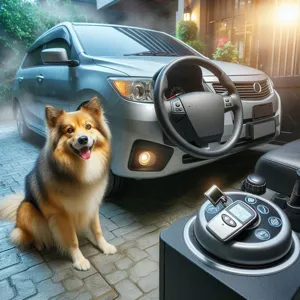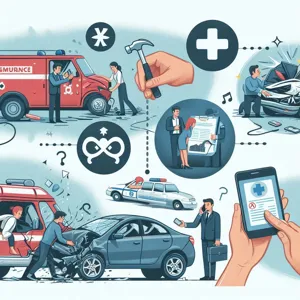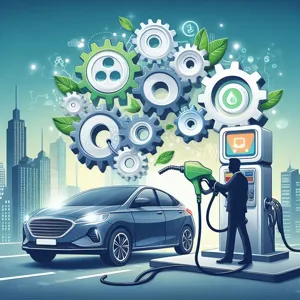When it comes to enhancing your driving experience, the right car accessories can make all the difference.
Whether you’re a daily commuter, a weekend road tripper, or an adventurous off-roader, selecting accessories that align with your lifestyle and needs can elevate both comfort and functionality. From practical gadgets that improve safety and efficiency to stylish add-ons that personalize your vehicle, the options can be overwhelming. In this essential guide, we’ll navigate the vast landscape of car accessories, helping you identify what truly enhances your driving experience. We’ll explore must-have items for every type of driver, tips for making informed decisions, and how to strike the perfect balance between utility and style. Get ready to transform your car into the ultimate driving companion, tailored specifically to your unique preferences and requirements!
1. Understanding Your Car Accessory Needs

When it comes to choosing the right car accessories, the first step is to clearly understand your needs and how you use your vehicle. Every driver is different, and your lifestyle will greatly influence the type of accessories that will enhance your driving experience.
Begin by reflecting on your daily routines and specific requirements. Are you a busy parent juggling kids’ activities and school runs? If so, consider accessories that enhance safety and convenience, such as child safety seats, backseat organizers, or sun shades that protect your little ones from harsh sunlight. Alternatively, if you’re an outdoor enthusiast who frequently embarks on weekend adventures, you might prioritize accessories like roof racks, cargo carriers, or all-weather floor mats that can withstand muddy boots and outdoor gear.
Next, think about your vehicle’s existing features. Does it have advanced safety technology that could be complemented by additional accessories, such as blind-spot mirrors or dash cams? Or perhaps you’re looking to personalize your vehicle’s interior with custom seat covers and steering wheel wraps that reflect your unique style.
Additionally, consider the climate and terrain in which you drive most often. If you live in an area with heavy snowfall or rain, investing in high-quality tires, snow chains, or weather-resistant seat covers can significantly enhance your safety and comfort. Meanwhile, if you frequently navigate city streets, accessories like parking sensors or compact phone mounts can make urban driving a breeze.
Ultimately, understanding your specific car accessory needs is about recognizing how various products can improve functionality, comfort, and safety while reflecting your personal style. Take the time to assess your driving habits and preferences to ensure you invest wisely in accessories that will truly enhance your driving experience.
2. Identifying Key Categories of Car Accessories
When it comes to enhancing your driving experience, understanding the key categories of car accessories is essential. Accessories can significantly improve both functionality and comfort, making your vehicle a true extension of your lifestyle. Here, we’ll break down the primary categories you should consider when selecting the right accessories for your needs.
**1. Safety Accessories**
Safety should always be your top priority, and equipping your vehicle with the right safety accessories can provide peace of mind on the road. Essential items in this category include first aid kits, emergency road kits, tire pressure gauges, and reflective warning triangles. Advanced options like dash cameras can also help document any incidents, offering an added layer of security.
**2. Comfort and Convenience Accessories**
Make your driving experience more enjoyable with comfort and convenience accessories. Think about investing in seat covers, steering wheel covers, and car organizers to keep your space tidy. Tech-savvy drivers might appreciate phone mounts, Bluetooth adapters, or USB chargers to ensure they remain connected while on the go. A good set of floor mats can also protect your vehicle’s interior, making it easier to clean and maintain.
**3. Performance Enhancements**
For those who crave a thrilling ride, performance accessories can elevate your vehicle’s capabilities. Upgrades like air filters, exhaust systems, and suspension kits can enhance your car’s power and efficiency. Whether you’re looking to improve handling or fuel economy, understanding your vehicle’s specifications and how certain accessories impact performance is crucial.
**4. Aesthetic Upgrades**
Personalizing your vehicle allows you to express your unique style. Aesthetic upgrades can include custom seat covers, decorative decals, and ambient lighting kits. These accessories not only enhance the visual appeal of your car but can also create a more welcoming atmosphere for you and your passengers.
**5. Technology Add-Ons**
In today’s digital age, tech accessories are a must-have for any vehicle. From advanced navigation systems to smart dash displays, technology can significantly enhance your driving experience. Consider features like parking sensors, backup cameras, and integrated infotainment systems that offer seamless connectivity with your devices.
By identifying and understanding these key categories of car accessories, you can make informed choices that align with your driving needs and personal preferences. Each category offers a plethora of options, so take the time to explore what’s available and discover how these accessories can transform your vehicle into a more functional, comfortable, and enjoyable space.
3. Safety Accessories: Enhancing Your Protection

When it comes to car accessories, safety should always be a top priority. In today’s fast-paced world, ensuring your vehicle is equipped with the right safety accessories can make a significant difference in protecting you and your passengers. Not only do these accessories enhance your overall driving experience, but they also provide peace of mind knowing that you are prepared for any unexpected situations on the road.
Start by considering essential items like a high-quality first aid kit. A well-stocked first aid kit should include bandages, antiseptic wipes, gauze, and emergency contact information. This small yet crucial addition ensures that you are ready to respond to minor injuries quickly, whether you are on a long road trip or running errands around town.
Another vital accessory is a roadside emergency kit. This should include items such as jumper cables, a tire inflator, flares, and reflective warning triangles. These tools are indispensable in the event of a breakdown or flat tire, allowing you to handle emergencies with confidence. Additionally, consider investing in a portable jump starter, which can come in handy when your battery unexpectedly dies, eliminating the need to rely on another vehicle for assistance.
Don’t overlook the importance of quality floor mats and seat covers. These not only protect your vehicle’s interior from spills and stains but can also contribute to overall safety. For instance, non-slip mats can help prevent your feet from slipping on the floors, while seat covers can add an extra layer of protection in case of an accident. Look for materials that are both durable and easy to clean, ensuring that your vehicle remains in top condition for years to come.
Finally, consider advanced safety technologies such as backup cameras or parking sensors if your vehicle doesn’t already have them installed. These accessories can significantly reduce blind spots and help you navigate tight spaces with ease, making your driving experience safer for everyone on the road.
By prioritizing safety accessories, you not only enhance your protection but also create a more enjoyable driving environment. After all, a safe journey is a happy journey—so equip your vehicle wisely!
4. Comfort and Convenience Accessories: Making Your Ride Pleasant
When it comes to enhancing your driving experience, comfort and convenience accessories play a pivotal role in transforming a mundane commute into a pleasurable journey. These accessories are designed not only to improve your comfort but also to streamline your daily routines, making every ride a little more enjoyable.
Imagine slipping into your car and instantly feeling the embrace of a plush seat cover that provides both warmth in winter and coolness in summer. High-quality seat cushions can alleviate fatigue during long drives, offering lumbar support that cradles your lower back and helps maintain good posture. For those who tend to endure extended hours on the road, investing in a heated seat pad or a cooling gel seat cushion can make a world of difference in how you feel by the time you reach your destination.
But comfort doesn’t stop at the seats. Consider adding accessories like steering wheel covers that offer a better grip and a touch of luxury. Plush, padded covers can reduce the strain on your hands, especially during long trips, while also keeping the wheel at a comfortable temperature. And don’t forget about the importance of ergonomic design in car accessories. Products such as custom-fit floor mats or sunshades not only protect your vehicle but also enhance your overall driving experience by keeping the interior clean and comfortable.
Convenience accessories are equally essential in this category. A well-placed phone mount can keep your device within easy reach, allowing you to navigate, answer calls, and listen to your favorite music without fumbling around. Moreover, investing in a quality car organizer can keep your essentials neatly tucked away, reducing clutter and making it easier to find what you need during your travels. From cup holders that accommodate larger beverages to backseat organizers that keep kids entertained, these small additions can significantly elevate your ride.
Ultimately, choosing the right comfort and convenience accessories for your car is about understanding your unique needs and preferences. By thoughtfully selecting items that enhance your comfort and streamline your routine, you can create a driving environment that feels personalized and welcoming, making every journey a more enjoyable one.
5. Technology Upgrades: Boosting Your In-Car Experience

In today’s fast-paced world, having the right technology upgrades in your car can transform your driving experience from mundane to extraordinary. As you navigate through your daily commute or embark on a weekend road trip, the right accessories can enhance comfort, safety, and entertainment, keeping you connected and engaged on the road.
**Smartphone Integration** is at the forefront of modern car technology. Upgrading to a system that supports Apple CarPlay or Android Auto can seamlessly connect your device to your vehicle’s infotainment system. This integration allows you to access navigation apps, stream your favorite playlists, and manage calls and messages using voice commands or simple taps, all while keeping your eyes on the road.
**Dash Cams** are another essential upgrade that not only provide peace of mind but also enhance your safety. These compact cameras capture high-definition video of your surroundings, creating a reliable record in case of accidents or disputes. Some models even offer features like parking mode, which monitors your vehicle while it’s stationary, providing an extra layer of security.
**Bluetooth Hands-Free Systems** are critical for maintaining focus while driving. By adding a Bluetooth kit or upgrading your car’s stereo system, you can take calls without fumbling for your phone, allowing you to stay engaged with your conversations without compromising safety. Look for systems that offer clear audio quality and easy connectivity, ensuring a hassle-free experience.
**GPS Navigation Systems** can significantly reduce the stress of getting lost, especially when traveling to unfamiliar areas. While many smartphones have built-in navigation, a dedicated GPS device can offer larger screens, real-time traffic updates, and the convenience of offline maps, ensuring you never miss a turn or get stuck in a jam.
Finally, consider investing in **Portable Chargers and Wireless Charging Pads** to keep your devices powered throughout your journeys. With multiple USB ports or a sleek wireless charger, you can ensure that everyone in the car stays connected, whether it’s for navigation or entertainment.
By carefully selecting these technology upgrades, you can significantly enhance your in-car experience, making every drive more enjoyable, safe, and efficient. Whether it’s enjoying your favorite podcast, navigating to new destinations, or keeping your devices charged, the right accessories can make all the difference on the road.
6. Performance Enhancements: Optimizing Your Vehicle’s Capabilities
When it comes to getting the most out of your vehicle, performance enhancements are key to unlocking its full potential. Whether you’re a weekend warrior seeking adrenaline-fueled adventures or a daily commuter looking to improve fuel efficiency, the right accessories can significantly elevate your driving experience.
Start by considering upgrades that enhance your engine’s performance. Cold air intakes and performance exhaust systems are excellent choices that allow your engine to breathe better, resulting in increased horsepower and torque. These upgrades not only promote better engine performance but also add a sporty sound that car enthusiasts love.
Suspension modifications, such as upgraded shock absorbers or lowering springs, can drastically improve your vehicle’s handling and stability. If you frequently navigate winding roads or encounter rough terrains, enhancing your suspension system can provide a smoother ride and better grip. In addition, performance tires can make a world of difference, offering improved traction and responsiveness, which is vital for both safety and driving enjoyment.
Don’t overlook the importance of brake upgrades. High-performance brake pads and rotors can dramatically reduce stopping distances and improve overall braking efficiency, giving you peace of mind as you push your vehicle to its limits.
Finally, consider investing in a performance tuner or programmer. These devices allow you to customize your engine’s tuning settings to better match your driving style, whether that means emphasizing fuel economy or maximizing power.
As you explore these performance enhancements, it’s essential to balance your desires with your everyday needs. Evaluate how each upgrade aligns with your driving habits and lifestyle. By making informed choices, you can optimize your vehicle’s capabilities and truly enjoy every journey, whether it’s a daily commute or an exhilarating road trip.
7. Aesthetic Accessories: Personalizing Your Car’s Look

When it comes to enhancing your vehicle, aesthetic accessories offer an exceptional opportunity to infuse your personal style into your car’s interior and exterior. From sleek seat covers to eye-catching decals, these accessories allow you to create an environment that reflects your personality while also elevating the overall appeal of your ride.
Consider investing in custom floor mats that not only protect your car’s flooring but also showcase your favorite colors or designs. If you’re a fan of vibrant hues, plush steering wheel covers can add a pop of color to your daily drive, making every journey feel more enjoyable. Think about adding ambient lighting to your car’s interior; LED strips can transform a mundane dashboard into a glowing spectacle, setting the mood for your travels, whether it’s a late-night drive or a weekend adventure.
Moreover, don’t overlook the exterior of your vehicle. A unique license plate frame or stylish rim trims can make your car stand out in a sea of similar models. Window tints not only enhance privacy but can also provide a sleek, polished look that complements your car’s design.
Personalizing your vehicle with aesthetic accessories doesn’t just make it visually appealing; it also creates an emotional connection. Every time you step inside, you’ll be reminded of your individuality and style, turning routine drives into personalized experiences. Whether you’re looking to impress others or simply enjoy a space that feels uniquely yours, aesthetic accessories are the perfect way to make your car truly reflect who you are.
8. Budgeting for Car Accessories: Finding the Right Balance
When it comes to enhancing your vehicle with car accessories, budgeting is a crucial step that can make or break your experience. With a plethora of options available, from essential safety gadgets to stylish upgrades, it’s easy to get carried away and overspend. To find the right balance, start by assessing your needs versus your wants.
Begin with a clear understanding of the accessories that are essential for your day-to-day driving experience. For instance, if you frequently travel long distances, investing in a high-quality phone mount or a comfortable seat cover may be more beneficial than splurging on decorative items. Prioritize your purchases based on functionality, safety, and the value they add to your driving experience.
Once you have identified your must-haves, set a realistic budget. Consider how much you are willing to spend in total and allocate your funds accordingly. It can be helpful to research prices and read reviews to ensure you’re making informed decisions. Sometimes, opting for mid-range products can yield better value for money than going for the cheapest or the most expensive options.
Don’t forget to leave a little room in your budget for unexpected finds or upgrades. Car accessories can often enhance your vehicle’s performance or comfort, and being flexible can lead to discovering great deals that are too good to pass up. Remember, the key is to strike a balance between functionality, quality, and price, ensuring that each accessory you choose contributes positively to your driving experience without putting a strain on your wallet.
9. Researching and Comparing Accessories: What to Look For
When it comes to choosing the right car accessories, thorough research and careful comparison are essential steps that can significantly enhance your driving experience. With the vast array of products available, it’s easy to feel overwhelmed. However, knowing what to look for can streamline the process and ensure you make informed decisions that suit your specific needs.
Start by identifying your primary objectives for purchasing accessories. Are you looking to improve safety, enhance comfort, or boost your vehicle’s aesthetics? For example, if safety is your priority, focus on accessories like child safety seats, high-visibility seat covers, or advanced dash cams that offer features such as night vision and collision warnings. On the other hand, if comfort is your main goal, consider heated seat covers, custom-fit floor mats, or ergonomic steering wheel covers that make long drives more enjoyable.
Next, pay attention to compatibility with your vehicle. Ensure that any accessory you consider is specifically designed for your car model, as this can affect both functionality and aesthetics. Reading user reviews and seeking recommendations from fellow car enthusiasts can provide valuable insights into how well an accessory performs in real-world conditions.
Additionally, compare the quality and durability of products from different manufacturers. Look for accessories made from high-quality materials that are built to withstand wear and tear. Warranty information can also be a telling factor; a robust warranty often indicates confidence in the product’s longevity.
Lastly, price comparison is crucial. While it’s tempting to go for the cheapest option, consider the long-term value of investing in higher-quality accessories that may come with a slightly higher price tag. Balancing cost with quality ensures you get the best bang for your buck, ultimately leading to greater satisfaction with your purchases.
By conducting thorough research and making careful comparisons, you’ll be well-equipped to select the right car accessories that not only meet your immediate needs but also enhance your overall driving experience for years to come.
10. Reading Reviews and Getting Recommendations
When it comes to choosing the right car accessories, reading reviews and getting recommendations can be the guiding lights in your decision-making process. In today’s digital age, countless resources are at your fingertips, allowing you to tap into the collective wisdom of fellow drivers—and their experiences can save you both time and money.
Start by exploring online platforms like Amazon, specialized automotive websites, and forums dedicated to car enthusiasts. These platforms often feature a wealth of user-generated content, including detailed reviews that highlight the pros and cons of various products. Look for accessories with a high number of reviews and a solid average rating; this usually signals a reliable product. Pay close attention to comments that discuss durability, ease of installation, and real-world performance, as these insights can be invaluable.
Additionally, consider reaching out to friends, family, or coworkers who share your passion for cars. Personal recommendations can provide a level of trust that online reviews sometimes lack. Someone you know may have firsthand experience with a particular accessory, offering you insights that you won’t find in a review.
Social media groups and car clubs can also be excellent sources for recommendations. Engaging in discussions within these communities allows you to gather diverse opinions and might even introduce you to accessories that you hadn’t previously considered.
In summary, leveraging reviews and personal recommendations not only enhances your understanding of the products available but also empowers you to make informed purchases that truly meet your needs. With the right research, you can ensure that every accessory you choose enhances your driving experience, making your time on the road more enjoyable and efficient.
11. Installation Considerations: DIY vs. Professional Help
When it comes to installing car accessories, one of the most critical decisions you’ll make is whether to tackle the project yourself or enlist the help of a professional. This choice can significantly impact not only the functionality of the accessory but also your overall satisfaction with the installation process.
**DIY Installation: A Hands-On Approach**
If you’re the type who loves to roll up your sleeves and dive into projects, a DIY installation might be right up your alley. Many car accessories, such as seat covers, floor mats, and certain types of phone mounts, are designed for easy installation and can often be completed with just a few basic tools. The sense of accomplishment that comes from successfully installing an accessory yourself can enhance your ownership experience and deepen your connection with your vehicle.
However, before you attempt a DIY installation, it’s essential to consider your skill level and the complexity of the accessory. While some items come with straightforward instructions, others may require more technical know-how, especially those involving electrical components, like dash cams or advanced audio systems. Taking the time to research installation videos or tutorials can provide valuable insights, but be prepared for the possibility of trial and error.
**Professional Help: Expertise at Your Service**
On the other hand, if you’re unsure about your abilities or simply prefer a hassle-free experience, seeking professional help is a wise choice. Certified technicians have the expertise and tools necessary to ensure that your accessories are installed correctly and safely. This can be particularly important for high-tech accessories or modifications that could affect your vehicle’s performance.
Additionally, professional installation often comes with guarantees or warranties, providing peace of mind that your investment is protected. You won’t have to worry about potential mishaps or damage to your vehicle, which can occur if an installation goes awry.
Ultimately, the decision between DIY and professional installation boils down to your comfort level, the complexity of the accessory, and how much time you’re willing to invest. Whichever path you choose, ensuring proper installation is key to enjoying your new car accessories to the fullest.
12. Seasonal Accessories: Preparing for Weather Changes
As the seasons change, so too do the needs of your vehicle. Choosing the right car accessories for different weather conditions is crucial not just for comfort, but also for safety. Seasonal accessories can significantly enhance your driving experience and ensure that your vehicle remains in top condition, regardless of what Mother Nature throws your way.
In the winter months, investing in high-quality snow tires can make all the difference. These tires are designed to provide better traction on icy roads, reducing your chances of skidding or getting stuck. Additionally, consider adding a set of tire chains for extra grip when driving through particularly treacherous conditions. Don’t forget about a sturdy ice scraper and a snow shovel—these tools can save you time and hassle when clearing your vehicle and driveway.
As temperatures rise in the summer, think about accessories that promote comfort and protection. Sunshades are essential for keeping your car’s interior cool and preventing UV damage to your dashboard and seats. Seat covers made from breathable materials can keep you comfortable during long drives, while a good-quality windshield protector can help reduce the wear and tear caused by relentless sun exposure.
Spring and fall also bring their own set of challenges. In the spring, pollen can wreak havoc on your car’s interior, so investing in high-quality air filters and seat protectors can help keep your space clean. During the fall, it’s wise to equip your vehicle with floor mats that can handle mud and debris from wet leaves, ensuring easy cleanup and protecting your floors.
Overall, being proactive about seasonal accessories not only enhances your comfort and safety but also prolongs the life of your vehicle. By preparing for the weather changes ahead, you can ensure that your car remains a reliable companion throughout the year, allowing you to drive with confidence no matter the forecast.
13. Maintenance Accessories: Keeping Your Car in Top Shape
When it comes to ensuring your vehicle remains in peak performance, maintenance accessories are your best friends. These often-overlooked tools and products play a crucial role in the longevity and efficiency of your car, saving you money and stress in the long run.
First on the list are oil change kits. Regular oil changes are vital for your engine’s health, and having a kit on hand makes it easy to perform this essential task yourself. Look for kits that come with high-quality oil and filters specifically designed for your vehicle model. This way, you can ensure that your engine operates smoothly and efficiently.
Next up are cleaning supplies. Keeping your car’s exterior and interior clean not only enhances its appearance but also protects it from the elements. Invest in a good-quality microfiber cloth, a gentle car wash soap, and perhaps a wax to give your car that showroom shine. Don’t forget about the interior—car vacuums, upholstery cleaners, and air fresheners can greatly improve your driving experience.
Tire maintenance is another critical aspect. A reliable tire pressure gauge, tire cleaner, and even a portable air compressor can be invaluable in keeping your tires in optimal condition. Regular tire checks can enhance safety and improve fuel efficiency, so having the right accessories on hand is a win-win.
Lastly, consider investing in a maintenance toolkit. A comprehensive set of tools can empower you to address minor repairs and adjustments, meaning you won’t have to rely solely on a mechanic for every little issue. Look for kits that include wrenches, screwdrivers, pliers, and fuses, all organized in a portable case for easy access.
By equipping yourself with the right maintenance accessories, you not only keep your car in excellent shape but also cultivate a deeper connection with your vehicle. After all, a well-maintained car is not just a mode of transport; it’s a reliable companion that carries you through life’s journeys.
14. Future-Proofing Your Accessories: Choosing Versatile Options
When it comes to selecting car accessories, future-proofing is a crucial consideration that can save you both time and money down the road. The automotive landscape is constantly evolving, with new technologies and trends emerging regularly. By choosing versatile accessories, you can ensure that your purchases remain relevant and functional, no matter how your vehicle or lifestyle changes.
Start by considering multi-functional products that can serve various purposes. For instance, a phone mount that can accommodate both your smartphone and larger devices, or a trunk organizer that can be adjusted to fit different cargo sizes, can be incredibly beneficial. These accessories not only maximize utility but also minimize clutter, keeping your vehicle neat and efficient.
Next, look for accessories that are compatible with a wide range of vehicle models and future technologies. Items such as universal chargers or Bluetooth-enabled devices can easily adapt to new gadgets or vehicles, ensuring that you won’t have to replace them as soon as you upgrade your car or switch devices.
Another key aspect of future-proofing is quality. Investing in high-quality, durable accessories means they are less likely to need replacement as styles and technologies change. For instance, well-made floor mats and seat covers can withstand wear and tear, while also maintaining a timeless aesthetic that complements your vehicle over the years.
Lastly, stay informed about industry trends and emerging technologies. Engaging with automotive communities and following relevant blogs can provide insights into the latest innovations and help you anticipate your future needs. By making informed choices now, you can select accessories that not only meet your current requirements but also adapt seamlessly as your lifestyle and vehicle evolve.
In essence, choosing versatile, durable, and forward-thinking car accessories will help you create a driving experience that’s not only enjoyable today but also ready for whatever tomorrow may bring.
15. Final Thoughts: Making Informed Decisions on Car Accessories
As we wrap up this essential guide on choosing the right car accessories, it’s vital to emphasize that informed decision-making is the cornerstone of enhancing your driving experience. Investing in car accessories should not merely be an impulse buy; rather, it should stem from a clear understanding of your needs, vehicle compatibility, and lifestyle preferences.
Before making a purchase, take a moment to assess what you truly require. Are you looking for added comfort during long drives, like seat covers and ergonomic cushions? Or maybe safety is your primary concern, prompting you to seek out high-quality dash cams and emergency kits. Perhaps you’re aiming to elevate your vehicle’s entertainment system with the latest tech gadgets. Whatever your objectives may be, aligning your accessory choices with your priorities will ensure that each addition enhances your vehicle’s functionality and your overall enjoyment behind the wheel.
Furthermore, don’t forget to consider the quality and durability of the accessories you choose. Opting for well-reviewed products from reputable brands can save you from the frustration of frequent replacements and ensure that your investments stand the test of time.
Lastly, keep your options open. The automotive accessory market is ever-evolving, with new innovations constantly emerging. Staying informed about the latest trends and technologies can lead you to discover accessories that not only meet your current needs but also anticipate future ones.
In conclusion, by taking the time to research, evaluate, and make informed choices, you can transform your vehicle into a personalized haven that reflects your lifestyle while enhancing safety, comfort, and convenience. Happy accessorizing!
In conclusion, choosing the right car accessories can transform your driving experience, making it safer, more comfortable, and enjoyable. By understanding your specific needs—whether it’s enhancing safety, boosting convenience, or adding a touch of personal flair—you can make informed decisions that will serve you well on the road. Remember to consider quality, compatibility, and practicality when selecting accessories, as these factors can significantly impact your overall satisfaction. We hope this essential guide has empowered you with the knowledge to navigate the vast array of options available. Now, go ahead and personalize your ride, and enjoy every journey with confidence and style! Safe travels!




































